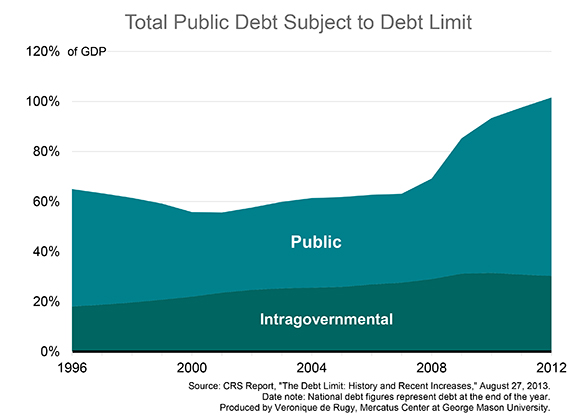- | Government Spending Government Spending
- | Data Visualizations Data Visualizations
- |
Thirty-Two Years of Bipartisan Debt-Ceiling Raises
This week’s chart series uses data from the US Treasury to illustrate the past 30 years of raising the debt ceiling. These charts show that raising the debt ceiling and living beyond our means is a bipartisan problem.

This week’s chart series uses data from the US Treasury to illustrate the past 30 years of raising the debt ceiling. These charts show that raising the debt ceiling and living beyond our means is a bipartisan problem.
Congress has the constitutional prerogative to control spending, and it does so through the debt ceiling, which sets the allowable limit of federal government borrowing. The first chart shows all the times that the debt limit has been raised since 1980, which includes 18 times under Ronald Reagan, four times under Bill Clinton, and seven times under George W. Bush. Most recently, President Obama raised the debt limit for his fifth time, to $16.69 trillion, $305 billion above the previous statutory limit, which is exponentially greater than when it first reached $1 trillion about 30 years ago in 1982.
Debt Subject to Limit
The debt limit applies to federal debt held by the public and by the government’s own accounts, also known as intergovernmental debt, which includes Social Security, Medicare, and Civil Service Retirement accounts. Of the $16.699 trillion in outstanding debt subject to limit, roughly $11.9 trillion is held by the public, and about $4.8 trillion is held by government accounts.
Simply raising the debt ceiling alone does nothing to address underlying drivers of our debt problem. The persistence of federal budget deficits has led to sustained growth in debt, thus requiring the government to issue increasing amounts of debt to the public. The second chart shows the growing portion of federal debt held by the public. Here are some key observations:
- public debt, which changes in response to surpluses or deficits, shrunk as a share of GDP in the late-1990s;
- from FY 1998 through FY 2001, the federal government ran surpluses and GDP was growing rapidly, which reduced debt held by the public;
- when large deficits returned and GDP growth slowed in the early 2000s, public debt increased again.
Historically, leaders from both parties have engaged in lifting the debt ceiling. The important discussion centers not on whether Congress should extend the debt limit, but whether and how these efforts can be tied to deficit-reduction measures.




